AMC used to sell Hornets – and Dodge used to sell Chargers (and Challengers). Now AMC – and the Charger and Challenger are gone – and Dodge sells a Hornet.
It’s nothing like the Hornet AMC – that’s American Motors Corporation – sold back in the ’70s. That one was rear wheel drive and available with a V8.
This one’s AWD – and powered by a four.
But it’s trying as hard as it can to be like the Charger and Challenger that Dodge isn’t allowed to sell anymore.
The Hornet is Dodge’s new compact crossover.
It effectively replaces the Charger and Challenger, which are no longer available (though one of the two will return later this year in battery-electric form) as Dodge’s performance car offering.
The standard GT trim ($30,735) touts the most powerful engine that’s available in the class – a 2.0 liter four that makes 268 horsepower.
But it’s the R/T version that Dodge hopes will keep alive memories of the Chargers and Challengers that bore that designation. This one’s a performance hybrid – touting 288 horsepower and the ability to regularly run on electricity rather than gas.
It stickers for $40,935 to start.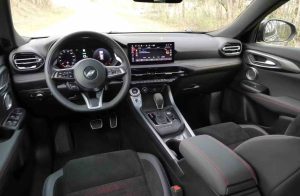
What’s New for 2024
The R/T plug-in performance hybrid version of the Hornet is new for ’24.
What’s Good
Tries to fill the huge hole left in Dodge’s lineup now that the Charger and Challenger are gone.
R/T hybrid goes fast – and can go about 32 miles without burning any gas.
Much more practical than a Charger or Challenger.
What’s Not So Good
R/T (with a four) costs almost as much as a Charger or Challenger did with a V8.
Standard AWD (both versions) means no more burnouts for you.
It’s the replacement for the Charger/Challenger rather than an alternative to them.
Interestingly, the R/T version of the Hornet comes standard with a smaller (1.3 liter) engine than the standard (2.0 liter) engine in the GT version of the Hornet. It’s interesting because – historically – R/T versions of Dodge vehicles have been the performance versions and these generally came with a bigger engine than what came in the standard-issue version of whatever the model was. For example, the Dodge Challenger and Charger came standard with a 3.6 liter V6 – but the R/T versions came standard with a 5.7 liter Hemi, an engine that’s become as politically incorrect as a catalytic converter test pipe.
But while the R/T’s 1.3 liter four cylinder engine is smaller, it is also stronger – and that is keeping in tune with the R/T tradition. It’s also something else that no prior R/T ever was.
That being burn no gas and hauls ass.
Well, less gas. Or even none – if you don’t call upon its power and instead rely on the electric side of the R/T’s plug-in hybrid drivetrain. Fully charged, the battery can take you about 32 miles without burning any gas, but without requiring you to stop when you run out of charge. When the charge wilts, the engine comes online to recharge it as you drive it – and to keep you driving, which is a huge everyday/functional advantage over an electric-only car. It’s also a regulatory advantage. Being able to operate as a part-time electric car lets Dodge continue selling vehicles with R/T badges that aren’t just badges. When the engine’s off, you see, it does not “emit” any of the dread gas carbon dioxide that constitutes about 0.04 percent of the Earth’s atmosphere; adding fractional amounts to that fractional amount is said to be causing the “climate” to “change.” Kind of like people who weren’t sick were “asymptomatically spreading” the ‘Rona by not wearing Face Diapers.
The combined output of the 1.3 liter engine and the hybrid-electric side is 288 horsepower (vs. 268 for the GT’s 2.0 liter engine) and 383 ft.-lbs. of torque, which is nearly as much torque as you used to be able to get in a V8 powered Charger or Challenger. The 5.7 liter Hemi in those two offered up 395 ft.-lbs.
The closer-to-home point is that there’s nothing in the Hornet’s class of small crossover that even comes close to offering that kind of power – or performance. The R/T version of the Hornet can get to 60 in just over 6 seconds.
Par for the class is 7.5 or so to 8.
A six speed automatic and AWD are standard.
Both versions of this small-but-powerful crossover are rated to pull up to 2,000 lbs.
Crossovers are very popular but not because they’re exciting. They are popular for the same reason that tires are popular. People need them. They are useful. Not many people who buy them even know which brand of tire their crossover came with. And most people can’t tell you which crossover is which in a parking lot. They are utilitarian appliances.
Here’s one that’s more than just that.
Here’s one that even sounds like more than just that.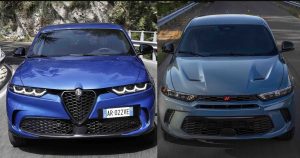
The Alfa Romeo 1.3 liter turbo four (“Alfa Romeo” is italicized because the Hornet is a reskinned Alfa Romeo Tonale that costs less money) has a rowdy exhaust note when you wake it up, as by selecting Sport mode, which focuses on burning rather than saving gas. Toggle through the hybrid and electric modes as you prefer. The latter allows silent running, which is something the Charger/Challenger were never able to do (unless you put them in neutral, shut off the engine and rolled them down a hill).
Of course, it’s not a Challenger or Charger.
It is what Dodge can offer now, in lieu of them.
It is a shame that Dodge could not offer the Hornet in addition to them. As an alternative to them – rather than a replacement for them, which is something it can never be, because it is an entirely different kind of vehicle. It could have brought people who wanted a crossover with some Charger/Challenger-like attitude, who needed something with the appliance-like practicality of a crossover, into the Dodge fold – and it may do just that. But it’s doubtful it will keep people who were Charger/Challenger buyers in the fold, notbecause it’s a bad vehicle but because those people don’t want a crossover or a four cylinder engine, no matter how it performs. For the same reason, essentially, that men who prefer blondes don’t want brunettes.
Now that the V8 Charger and Challenger are gone, the most likely probable alternative for those who want something like that is the Durango R/T, which you can still get and with a V8.
But probably not for much longer, either.
Expect the ’24 Durango R/T (with a V8) to be the last call Durango R/T with a V8.
The Hornet is little – just 178 inches end to end – but it’s still several inches longer than the next-sportiest small crossover in the class, Mazda’s CX-30 (which is just 173 inches long). But it also has a smaller footprint than other crossovers in the class, such as the Hyundai Tucson (which is 182.3 inches long).
So, it’s a compact – but not a subcompact. What that means in practical terms is a split-the-difference difference in cargo capacity between what’s available in subcompact crossovers such as the CX-30 (which has 20.2 cubic feet of space behind tis second row) and the 38.7 cubic feet that’s available behind the second row of the Tucson. The Hornet’s got 27 cubic feet – expandable to 54.7 with them folded forward. That’s enough space to accommodate a roughly four foot wide, five foot tall tool box broken down into two pieces. I know this because I used a Hornet to haul one of those from Home Depot home. This is something I could not have done with a Charger or a Challenger, much as I love them. It’s why I have a truck in addition to my old Pontiac Trans-Am, which is a muscle car similar to those cars).
The R/T, as per tradition, not only comes with a stronger drivetrain. It also comes standard with more powerful (Brembo) brakes and a set of larger (18 vs. 17 inch) wheels with shorter sidewall (stiffer) tires and a sport-tuned, firmer-riding suspension as well as additional performance-themed displays and readouts inside.
A Track Pack ($2,595) is available that replaces the 18 inch wheels with a 20 inch set (and ultra-low-profile performance tires), red powder-coated Brembo calipers and an upgraded sport suspension with adjustable dampers. There’s also a less functionally aggressive Blacktop Package ($1,595) that includes gloss black trim and “Dark Hornet” badges plus a set of Abyss black wheels (18 inches) unique to this trim.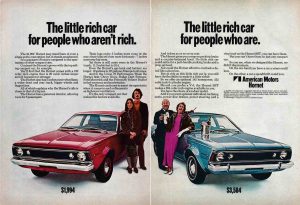
The Rest
It’s interesting that Dodge chose to name this four cylinder-powered, five-door crossover after a rear-drive, V8-powered AMC muscle car. Then again, Ford calls its small hybrid truck a Maverick – and the latter was a car back in the ’70s.
More interesting, arguably, is that the Dodge Hornet isn’t cheap – which the AMC hornet was. The base 1970 model stickered for just shy of $2,000 – which wasn’t much then and still isn’t, today. Adjusted for devaluation – the more accurate term for the reduced buying power of money – that ’70 Hornet cost just over $16k, today. Even with the optional V8 ,it cost much less than the four cylinder-powered Hornet GT.
The turbo-hybrid R/T meanwhile, costs nearly as much as what a V8-powered Charger R/T cost last year (which was $42,940) and the Charger was a much larger car with a much larger engine – and much larger personality.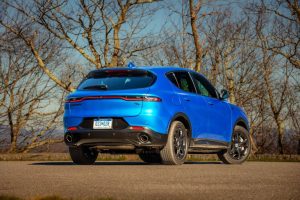
That’s an example of shrinkflation applied to transportation.
The Bottom Line
It’s not a Charger or Challenger. But at least it’s not just another appliance, either.
. . .
If you like what you’ve found here please consider supporting EPautos.
We depend on you to keep the wheels turning!
Our donate button is here.
If you prefer not to use PayPal, our mailing address is:
EPautos
721 Hummingbird Lane SE
Copper Hill, VA 24079
PS: Get an EPautos magnet or sticker or coaster in return for a $20 or more one-time donation or a $10 or more monthly recurring donation. (Please be sure to tell us you want a magnet or sticker or coaster – and also, provide an address, so we know where to mail the thing!)
If you like items like the Keeeeeeev T shirt pictured below, you can find that and more at the EPautos store!



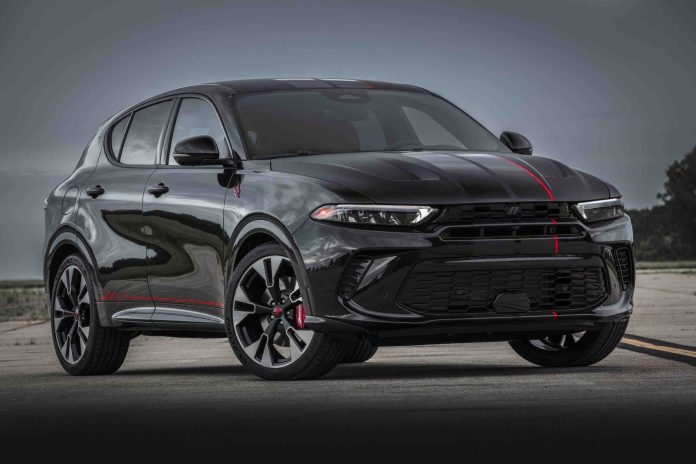

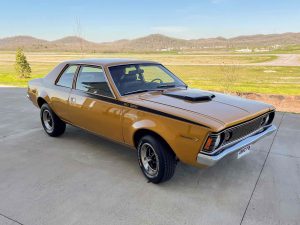



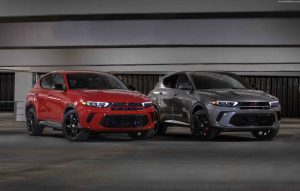







Looks like BMW X1. Would be interesting comparison.
If it was half the price they might have had something. It won’t sell because the price is too high.
It’s a shame the ’71 AMC Hornet SC/360 wasn’t more successful. It was a hot little car with the 360 V-8 and could rip off a 13-second quarter with good conditions. American Motors only sold 700 something of them. Seeing one today is like seeing a unicorn.
$40k for a 1.3L ?
That’s $10,000 per 19.8 cubic inches.
How long will that engine last?
I always thought the AMC Matador was badass after Bobby Allison drove the red/white/blue beast in NASCAR.
“How about just bringing back the classic, pulchritudinous Challenger, so I can grope my filthy paws over its hip flares while growling my visceral approval?”
That’s a good one. Reminds me of the Mercury Mistress on SNL (back when it offered humor):
https://www.dailymotion.com/video/x359dd
Oops, This was a reply to Jim H below.
‘Those people don’t want a crossover or a four cylinder engine … for the same reason that men who prefer blondes don’t want brunettes.’ — eric
Today’s automotive market has become a Harrison Bergeron-style ‘diverse’ beauty contest. In place of the traditionally beautiful (banned for their unfair advantage), all others now are welcome: the rotund; the stridently plain; the ladyboys with a y-chromosome.
Likewise, with the pin-up girl Chargers and Challengers evicted and erased, what’s left is a motley collection of pricey wannabes like the Hornet R/T — an exceedingly plain girl who got a five-figure price tag, 24-hour makeover on TeeVee and then was turned loose to work her wiles on a scrum of eligible bachelors. Hoflation, as they call it.
But we’ve all seen this trite plot before, and it’s getting old. How about just bringing back the classic, pulchritudinous Challenger, so I can grope my filthy paws over its hip flares while growling my visceral approval?